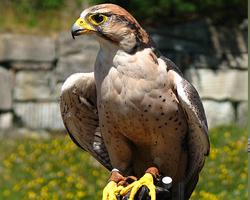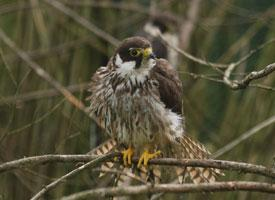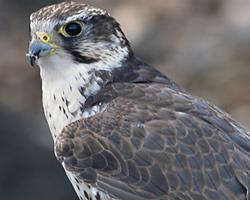
Súlyok és méretek
| Hossz | 30-tól 40-ig cm |
|---|---|
| Súly | 208-tól 460-ig g |
| Szárnyfesztávolság | 90 cm |
Állatleírás
The Aplomado Falcon (Falco femoralis) is a striking bird of prey that belongs to the family Falconidae, which encompasses other falcons and caracaras. This medium-sized raptor exhibits a sleek and powerful build, perfectly adapted for speed and agility, which it employs with remarkable efficiency in the hunt for prey. The species is distributed across a broad range that spans from the southwestern United States through Central America and into much of South America, favoring open landscapes such as savannas, grasslands, and marshes, as well as the edges of forests.One of the most distinctive features of the Aplomado Falcon is its plumage. Adults have a striking pattern of contrasting colors: their upperparts are predominantly dark slate gray, while the underparts exhibit a beautiful pattern of white and rusty-orange stripes. A characteristic facial feature is the dark malar stripe beneath each eye, which contrasts sharply with the otherwise pale face, enhancing its keen-eyed appearance. The long, banded tail and relatively long wings contribute to its silhouette, making it a graceful and formidable presence in its habitat.
With a body length ranging from 30 to 40 cm (12 to 16 inches) and a wingspan of about 90 cm (35 inches), the Aplomado Falcon is larger than many other falcons but smaller than the more widely known Peregrine Falcon. Its size, however, does not detract from its speed and agility in flight. These falcons are adept hunters, preying on a variety of animals including insects, birds, and small mammals. They are known to hunt in pairs or family groups, using sophisticated tactics such as flushing prey towards each other.
Breeding behavior of the Aplomado Falcon involves the construction of nests in trees, cacti, or on cliff ledges, often utilizing the abandoned nests of other large birds. These falcons are monogamous, with pairs exhibiting strong bonds and often returning to the same nesting sites year after year. The female typically lays 2 to 3 eggs, which are incubated for about a month. Both parents share in the rearing of the young, which fledge approximately 5 to 6 weeks after hatching.
The conservation status of the Aplomado Falcon has been a concern, particularly the northern populations which have experienced significant declines due to habitat loss, pesticide use, and other human-related factors. Conservation efforts, including habitat restoration and the reintroduction of captive-bred falcons, have been initiated to help stabilize and increase populations in areas where they have declined.
In summary, the Aplomado Falcon is a remarkable and beautiful bird of prey, known for its striking appearance, agile flight, and sophisticated hunting techniques. Despite facing challenges in conservation, efforts to protect and restore this species offer hope for its continued presence across its historic range.
Hasonló állatok
Új állatfotók
Top 10 állat
- Dolphin gull (Leucophaeus scoresbii)
- Diana monkey (Cercopithecus diana)
- Moustached guenon (Cercopithecus cephus)
- Galápagos tortoise (Geochelone nigra complex)
- Japanese macaque (Macaca fuscata)
- Russian tortoise (Testudo horsfieldii)
- Stone loach (Barbatula barbatula)
- Greek tortoise (Testudo graeca)
- Common flying dragon (Draco volans)
- Vendace (Coregonus albula)


